Black Migrations to Sierra Leone (1792 and 1800) National Historic Event

© Maritime Museum of the Atlantic, Halifax, Nova Scotia, a part of the Nova Scotia Museum, M2008.38.1.
The Black Migrations to Sierra Leone (1792 and 1800) were designated a national historic event in 2023.
Historical importance: Exemplifies the frustrations and disillusionment of self-emancipated and free people of African descent in Nova Scotia and New Brunswick.
Commemorative plaque: no plaque installedFootnote 1
Black Migrations to Sierra Leone (1792 and 1800)
The migrations of Black Loyalists and Jamaican Maroons to Sierra Leone in 1792 and 1800, respectively, exemplified the frustrations and disillusionment of self-emancipated and free people of African descent in Nova Scotia and New Brunswick. Their rejection of long-term settlement had a lasting impact on diasporic African communities in the Maritimes, not least by significantly reducing the number of free people of African descent in the colonies. The migrations resulted in the creation of unique and invaluable records of their lives and experiences.
I am delighted that my successful advocacy for Black representation over years has resulted in this important symbol. This designation adds to the complexity of the experience of freedom for enslaved and formerly enslaved Africans in Canada, their experience and their approach to ameliorating their condition. Their resilience was amplified by their advocacy and reconnects them to Africa.
The first to leave were 1,196 of the estimated 3,500 free or self-emancipated people of African descent evacuated from the Thirteen Colonies after supporting Britain during the American Revolutionary War (1775–1783). Their departure in 1792 spoke to the hardships they endured in Nova Scotia and New Brunswick. There, few received the farmland promised to them, forcing many into exploitative wage labour, sharecropping, or indentured servitude. All faced unequal treatment under the law and constant threats of mob violence and (re-)enslavement. Thomas Peters, who had fought on the side of Britain as a sergeant in the Black Pioneers, helped organize the move in partnership with John Clarkson—a British abolitionist, officer of the Royal Navy, and agent for the Sierra Leone Company of London. Many prominent leaders left close-knit Black Loyalist communities in the Maritimes for Sierra Leone, including preachers Boston King, Moses Wilkinson, and David George, and teacher Catherine Abernathy. After the migration of 1792, there were no longer enough residents to keep churches and schools open in Birchtown, Brindley Town, and other rural communities. Many of the Black Loyalists who remained in Nova Scotia and New Brunswick subsequently moved to larger towns and cities, especially Halifax.
This designation honours the memory of those ancestors who made the momentous journeys, and is truly a milestone in the history of Canada, Sierra Leone, and the Black Atlantic. It recognizes the vision, steadfastness, and courage of the Black Loyalists and Maroons to carve out for themselves spaces of freedom and self-actualization.
More than 500 Jamaican Maroons followed the Black Loyalists to Sierra Leone in 1800. They had been exiled to Nova Scotia after the second and final Maroon War (1795–1796). In Nova Scotia, they could not grow tropical crops central to their food culture, and they faced significant pressures to abandon traditional Akan social, spiritual, and cultural practices, and undertake hard physical labour on building projects and farms. After four years of tireless petitions to authorities in Nova Scotia and Britain, they finally secured the chance to leave Nova Scotia for Sierra Leone in 1800. Local authorities used this second mass migration as further justification to deny land grants to free people of African descent, arguing that they would inevitably leave the colony, and to justify largely unsuccessful attempts to resettle Black Refugees of the War of 1812 in the British colony of Trinidad.
This press backgrounder was prepared at the time of the Ministerial announcement in 2023.
The National Program of Historical Commemoration relies on the participation of Canadians in the identification of places, events and persons of national historic significance. Any member of the public can nominate a topic for consideration by the Historic Sites and Monuments Board of Canada.
- Date modified :